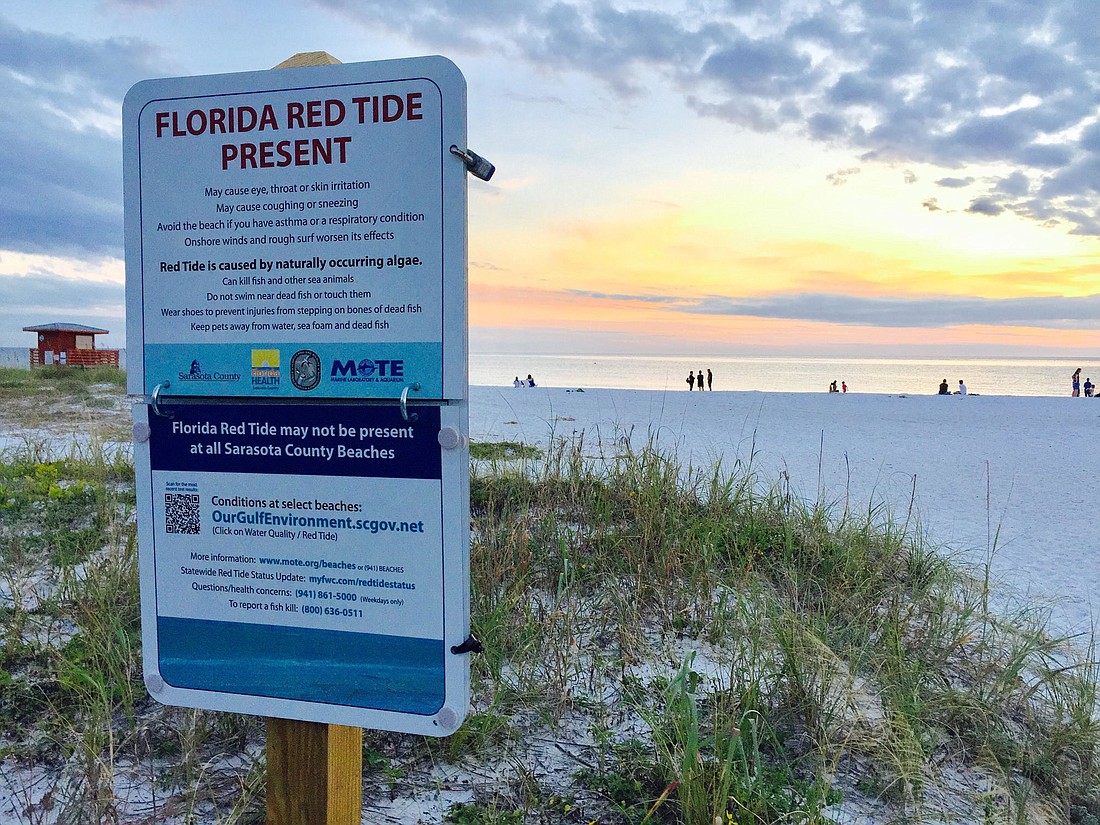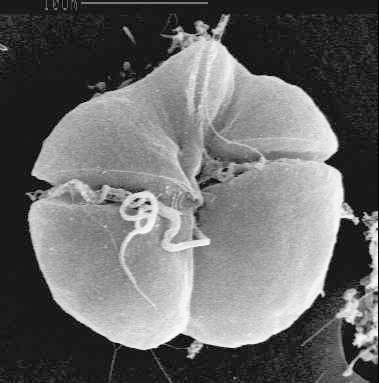- April 4, 2025
-
-
Loading

Loading

While much research still needs to be done on the life cycle of red tide blooms, representatives from Mote Marine Laboratory and the Florida Fish and Wildlife Conservation Commission share the science behind them. We explain the life cycle of a bloom, through its four known stages: initiation, growth, maintenance and termination. Also, we present some of the factors that can contribute to red tide blooms.
1) Initiation: Florida red tide develops 10-40 miles offshore, when the single-celled Karenia brevis organism gathers in large concentrations.
It is normally present in background concentrations, but once optimal conditions occur, including sunlight, temperatures, oxygen and nutrients, the cells begin dividing and proliferating.
Florida Fish and Wildlife Conservation Commission research scientist Kate Hubbard said large red tide blooms are due to K. brevis cells asexually reproducing, dividing to the point where they begin crowding out other organisms and form a bloom of algae cells.
2) Growth: Vincent Lovko, a Mote Marine Laboratory scientist, said what causes K. brevis to grow into a bloom is still a mystery.
According to FWC research, physical and biological conditions such as sunlight, temperature, nutrients and salinity all play a role.
Hubbard said a process called upwelling, or the rising of seawater from the depths toward the surface, can transport the bloom to the surface and bring it closer to the shore. It’s there that scientists believe nutrients from land-based sources help it reproduce, but it’s a complicated cycle that still needs research (see red tide factors).
For example, another type of algae, trichodesmium, can also aggravate red tide, Hubbard said. Trichodesmium is a blue-green algae that, upon coming into contact with red tide, takes nitrogen from the air and converts it into nutrient forms that K. brevis can use to grow. According to Mote, it usually precedes or accompanies red tides in Florida.

3) Maintenance: Once it blooms, red tide can expand or stay present essentially until it runs out of nutrients.
Lovko said that typically during the maintenance stage, the blooms are close to the coast, approximately within 10 miles. One of the main nutrients then is land-derived nutrients from estuary flow.
Hubbard said K. brevis can use 13 nutrients to help it grow, and Mote research has shown one of the organism’s strengths is its ability to use a broad range of nutrients.
Scientists at FWC test water samples and keep an eye on the weather and currents that could help red tide grow. But as of yet, there is little they can do to mitigate its effects.
“It seems like having the ocean physics be more conducive to keeping the red tide closer to the shore rather than having it dissipate is a huge factor that can contribute to lasting blooms,” Hubbard said. “This past year, we had a lot of northern and southern transport and that really helped keep things around rather than pushing them offshore.”
As blooms persist, they release toxins harmful to other marine life. This further fuels the cycle as fish killed by the toxins then provide a source of nutrients for the algae.
4) Termination: Red tides can last as little as a few weeks or longer than a year and can expand as far as 10,000 square miles from the surface of the water all the way to the seafloor. Sometimes it subsides and reoccurs. Because of this, there is currently no practical way to control or kill red tide blooms.
Lovko said there are a number of ways algal blooms can terminate, and it’s usually when a bacteria, virus or parasite attacks them, but whether or not this happens with K. brevis needs more research.
Termination can be simple as a change in water circulation patterns that help disperse the bloom, Lovko said. A change in the water circulation can help disperse the algae, breaking up the bloom and ending the cycle.
Storms and runoff: While runoff does not play a direct role in the initiation of red tide, it can fuel red tide blooms once they are present near shore.
“There’s been some limited research that overall, along the coast, there does seem to be a correlation between rainfall and runoff and large red tide blooms, but then when you break that into individual rivers and red tide, that locality doesn’t hold up,” said Vincent Lovko, a Mote Marine Laboratory scientist.
Lovko said because there aren’t serious blooms every year or in the same pattern, it’s hard to tell the influence of runoff. He said under normal circumstances, there might be a high nutrient flow into an estuary, but the mangroves in that estuary can soak up a lot of the runoff before it gets to a coastal system.
Florida Fish and Wildlife Conservation Commission research scientist Kate Hubbard said different factors, such as precipitation and ocean currents, can play a role in increasing red tide. Ocean currents such as the Gulf of Mexico’s loop current can bring the red tide bloom closer to the shore. Once there, factors such as precipitation and runoff can move man-made nutrients into the ocean, which can fuel red tide’s growth.
Lovko said the notion that a storm can break up a bloom is not far-fetched, but it doesn’t occur often.
Agriculture: There are 13 nutrients that can cause red tide to grow. If man-made forms of nutrients such as nitrogen or phosphorus find their way into an estuary system, they could fuel a red tide bloom.
“When you add more nutrients than are supposed to be there, you can disrupt the ecology,” Lovko said.
Septic/Wastewater: Like runoff, sewage does not play a direct role in the initiation of red tide, but it can fuel red tide blooms once they are transported near shore.
Temperature: While Lovko said it’s hard to pinpoint the exact role temperature plays into red tide, he said it probably does have some effect. Air temperature changes the water temperature, which could affect the circulation patterns of water. Typically, Lovko said blooms are more visible to scientists in cooler months, usually starting in late summer or early fall. Blooms then tend to persist into the winter months.
Fish kill: Red tide-causing algae Karenia brevis produces brevetoxins that affect the central nervous system of fish, often causing them to die. Less commonly, K. brevis also can kill fish by depleting the water of dissolved oxygen.
Those dead fish then become a source of nutrients that can intensify the bloom.